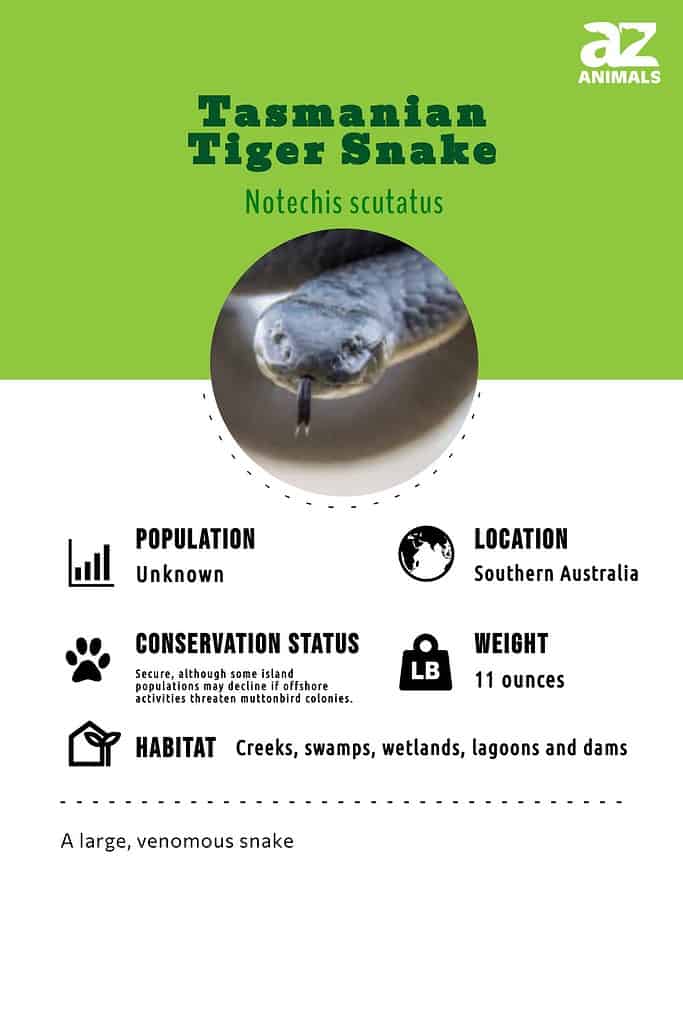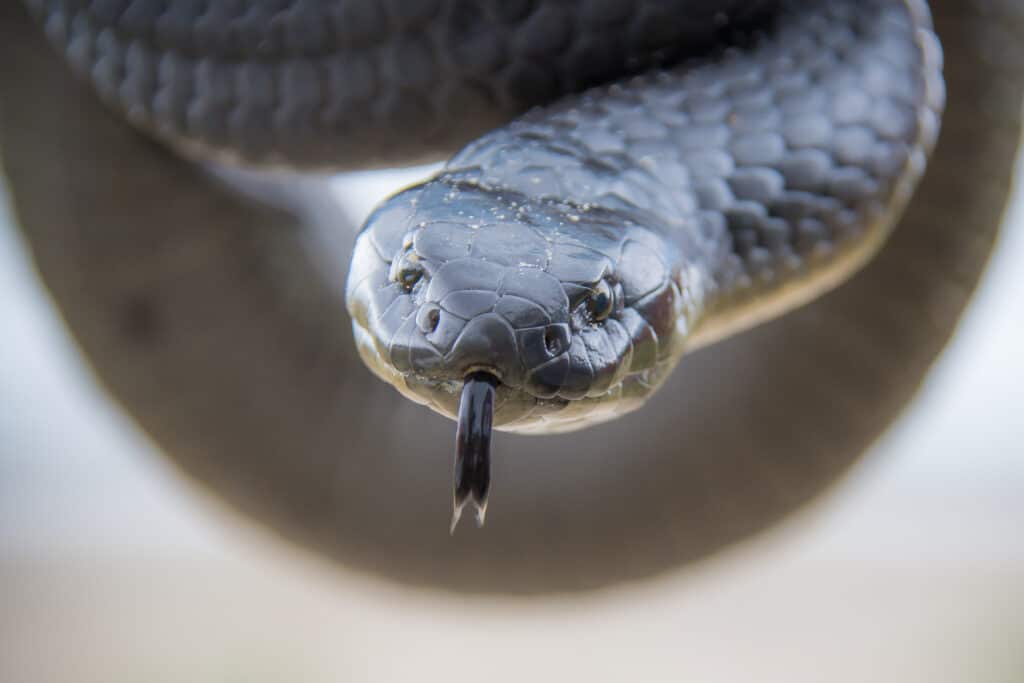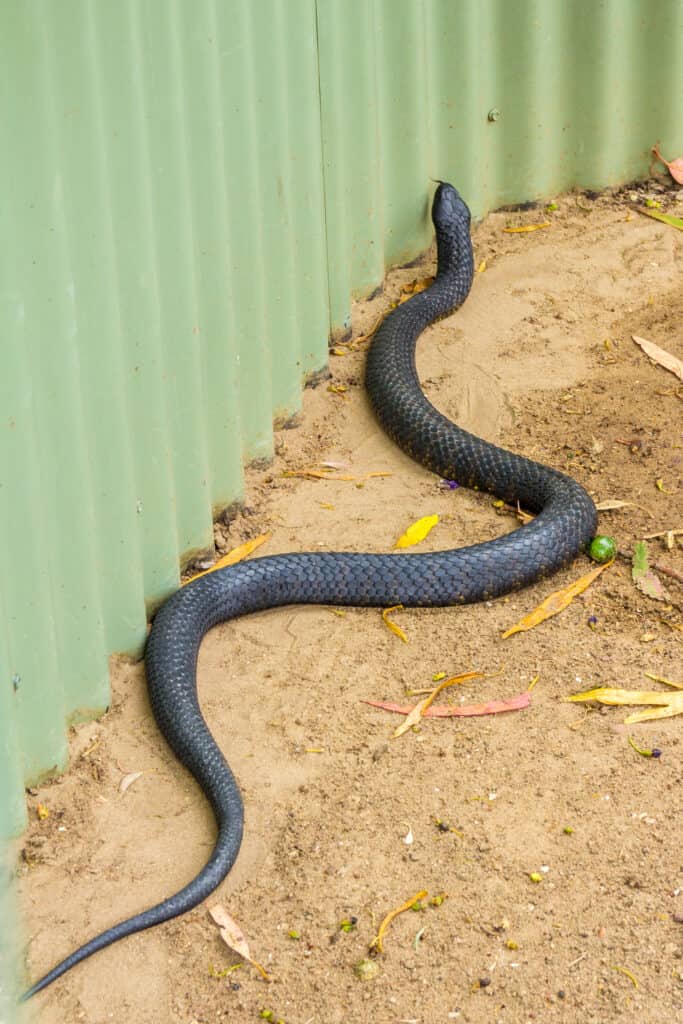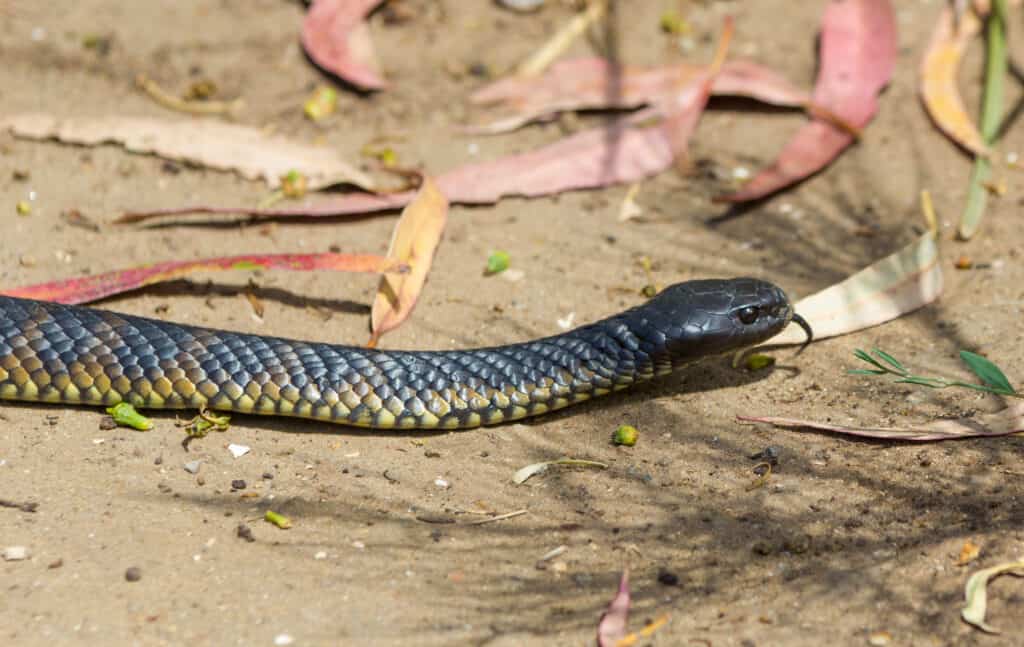Tasmanian Tiger Snake
Notechis scutatus humphreysi
The Tasmanian tiger snake gets its name from their banded skin, closely resembling a tiger's stripes.
Advertisement
Tasmanian Tiger Snake Scientific Classification
- Kingdom
- Animalia
- Phylum
- Chordata
- Class
- Reptilia
- Order
- Squamata
- Family
- Elapidae
- Genus
- Notechis
- Scientific Name
- Notechis scutatus humphreysi
Read our Complete Guide to Classification of Animals.
Tasmanian Tiger Snake Conservation Status
Tasmanian Tiger Snake Facts
- Prey
- Birds, lizards, frogs, tadpoles, small mammals
- Name Of Young
- Snakelets
- Group Behavior
- Solitary
- Solitary except during mating season
- Fun Fact
- The Tasmanian tiger snake gets its name from their banded skin, closely resembling a tiger's stripes.
- Most Distinctive Feature
- Their tiger-like stirpes
- Age Of Independence
- 0 days
- Litter Size
- 10 to 64
- Habitat
- Near dams, lagoons, creeks, swamps, or wetlands
- Diet
- Carnivore
- Lifestyle
- Diurnal/Nocturnal
- Common Name
- Tasmanian tiger snake
- Origin
- Tasmania
View all of the Tasmanian Tiger Snake images!
Tasmanian tiger snakes get their name from the black and yellow crossbands on their bodies. However, not all tiger snakes have these markings.
These snakes often occur near water sources like dams, creeks, lagoons, swamps, wetlands, and even drains. In addition, their large size, aggressive nature, and toxic venom make these snakes dangerous to humans.

Amazing Facts
- The Tasmanian tiger snake can grow to lengths of 3 to 7 feet, and the males are bigger than the females.
- Their coloring depends on their habitat
- These snakes are aggressive, and their venom is dangerous to humans
- The Tasmanian tiger snake gets its name from their banded skin, closely resembling a tiger’s stripes.
- Tasmanian tiger snakes are primarily active during the summer on hot days.
- These snakes have no parental instincts, their young are born in a membranous sac, and once the snakelets break out, they are entirely independent.
Habitat: Where to Find Them
Their name says it all: these tiger snakes are native to Tasmania and usually occur near dams, lagoons, creeks, swamps, or wetlands.
Tasmanian tiger snakes will often find shelter inside or underneath a fallen tree, in abandoned animal burrows, or in dense vegetation.
These snakes are great climbers and are one of few species of Australian elapids that can climb on human construction and vegetation.
Scientific Name

Tasmanian tiger snakes have neurotoxic venom.
©Joel Everard/Shutterstock.com
The Tasmanian Tiger Snake’s scientific name was recently changed to Notechis scutatus humphreysi, and they belong to the order Squamata, which is one of the most diverse orders in the Class Reptilia, comprising approximately 7,400 species, including:
These snakes belong to the Family Elapidae, also referred to as elapids. Members of this family are venomous and defined by their hollow, short, and permanently erect fangs.
There are over 300 species in the Elapidae family in around 60 genera; this includes species that live in arboreal, terrestrial, and marine environments. Other members of this family include:
Elapids occur mainly in tropical and subtropical regions, including Australia, Asia, Africa, and North and South America. In addition, they occupy regions of the Pacific and Indian Oceans.
Population and Conservation Status

These snakes often occur near water sources like dams, creeks, lagoons, swamps, wetlands, and even drains.
©Andrew Balcombe/Shutterstock.com
The Tasmanian tiger snake is listed as Least Concern on IUCN’s Redlist because its population is stable. However, their exact population size is unknown.
The Tasmanian tiger snake has few natural predators due to its size, speed, and potent venom. The primary predator of the Tasmanian tiger snake is the white-bellied sea eagle, which will prey on juvenile snakes as well as adults. Other potential predators include large carnivorous mammals such as foxes and cats, although this threat is less common than predation from birds.
In addition to predation, there are other threats to the survival of the Tasmanian tiger snake, which could be more significant in some areas than others. Habitat loss due to human encroachment is a major problem for these snakes. They require open grassland or forested habitats with adequate cover in order to survive and reproduce successfully. Additionally, road mortality can be an issue if roads intersect their habitat. Many individuals are killed when attempting to cross busy highways or city streets. Finally, climate change poses a serious threat by altering temperatures over time. Extreme heat or cold can cause population declines within certain areas where conditions become unsuitable for their survival.
Appearance and Description

These snakes have no parental instincts, their young are born in a membranous sac, and once the snakelets break out, they are entirely independent.
©Andrew Balcombe/Shutterstock.com
The Tasmanian tiger snake gets its name from their banded skin, closely resembling a tiger’s stripes. However, this snake has several variations depending on the species. For example, a mainland snake or common tiger snake has a fuller body with a flat, blunt head. Their coloring is primarily olive, green, or brown.
Or, the Chappell Island tiger snake, which is massive and has an olive-brown or black body. In addition, their crossbands are lighter. But the Tasmanian tiger snake is black with yellow crossbands, gray with no crossbands, or brown.
5 Types of Tiger Snakes
There are several subspecies of tiger snakes, and they include:
Krefft’s Tiger Snake (Notechis ater ater )
The Krefft’s tiger snake can be identified by its small size, black body, venom color, and the number of scales. Their black coloring transitions to dark gray as it reaches the belly, covered with smooth scales.
In addition, they have faint dark or light crossbands along their body, which are especially visible on juveniles. These snakes can reach a maximum length of 4 feet, and the females are bigger than the males.
Peninsular Tiger Snake (Notechis ater niger )
The Peninsular Tiger snake is extremely venomous and can grow between 4 to 6 feet long. They are native to southern Australia, specifically the coastal areas, including the lower Eyre Peninsula, York Peninsula, and the Great Australian Bright ocean.
Chappell Island Tiger Snake (Notechis ater serventyi )
The Chappell Island tiger snake is black in color, which helps to warm their bodies while sunbathing, but at night they take cover in Mutton birds’ burrows. In fact, the only time Chappell Island tiger snakes eat is during the Mutton birds’ breeding season, which is 2 to 3 months a year.
Their bodies have adapted to store large amounts of oil from the chicks, which Chapelle Island tiger snakes survive on for the rest of the year until the mating season begins again.
Western Tiger Snake (Notechis scutatus occidentalis)
The Western tiger snake primarily occurs on the coastal plains and the ranges that run alongside the plains. In addition, they have been sighted along the Canning and Swan rivers, as well as the Garden and Carnac Islands.
These snakes have large, stout bodies with blunt and broad heads. They are dark –brown or black in color with orange, yellow, or cream crossbands.
The Western tiger snake is often observed in water during the day and night because they are diurnal and nocturnal. In addition, they can withstand cold weather. They are not big biters and will only attack if touched.
Eastern Tiger Snake (Notechis scutatus scutatus )
The Eastern tiger snake occurs mainly in Victoria, New South Wales, and certain regions of South and Western Australia. They prefer grassy areas near water but are also found in arid regions. They are shy snakes and will rather flee than fight. However, if cornered, they will bite, and their venom is extremely toxic and dangerous.
Venom: How Dangerous are They
The Tasmanian tiger snake is large and often aggressive. But what is most scary about this snake is its neurotoxic venom, which is deadly to humans.
The venom of the Tasmanian tiger snake is one of the most potent among Australian species. Their venom has a neurotoxin element that affects the nervous system, causing paralysis and respiratory failure in extreme cases. While bites from this species are rare, they can be fatal if not treated quickly with antivenom or other medical interventions. Symptoms of a bite include intense pain at the site, swelling, tingling, and numbness around the area as well as rapid heart rate and nausea. It is important to seek immediate medical attention after being bitten by any kind of snake to avoid serious complications or death.
Behavior
Tasmanian tiger snakes prefer living in moist environments such as wet forests and grasslands where they can find plenty of prey, such as frogs, lizards, birds, and small mammals. These snakes are often active during the day when temperatures are warm enough for them to move around quickly and hunt efficiently. However, during colder months, they will become nocturnal or dormant until conditions improve.
Tasmanian tigers typically don’t attack unless provoked. Instead, they usually choose to flee from potential predators or hide rather than engage in a physical confrontation. However, if cornered or threatened, these animals will defend themselves by coiling up into a tight ball before striking out at whatever may be threatening it with its sharp fangs filled with powerful neurotoxic venom that can cause paralysis and even death if untreated promptly.
Diet
In general, Tasmanian tiger snakes eat:
The snake’s size will determine the size of the prey it will eat. As their body length increases, so does their prey. The Tasmanian tiger snake is primarily diurnal, as they do most of their hunting during the day. However, it’s not rare to spot them foraging in the early evenings as well.
These snakes are willing to swim underwater and can stay below the surface for up to 9 minutes. In addition, a bat was once found in a museum specimen’s stomach, meaning they are good climbers. In addition, Tasmanian tiger snakes can be cannibals. They inject each other with their potent venom and quickly subdue members of their species by constricting.
Reproduction
During the mating season, Tasmanian tiger snake males start to compete for females by engaging in combat and trying to press their opponent’s head down, which can result in these snakes becoming partially intertwined.
Their mating season is usually during late summer, but it is actually unclear when their breeding season occurs in the wild. Mating this late in the season is beneficial to southern species, as it gives them a head–start before spring. However, their mating ritual is lengthy and can take up to 7 hours.
Female Tasmanian tiger snakes are relatively stationary during this time and can stay in their nests for 50 days at a time. In addition, they give birth to live snakes between March and May, with an average litter size of 10 to 64 snakelets.
These snakes have no parental instincts, their young are born in a membranous sac, and once the snakelets break out, they are entirely independent.
Up Next
View all 133 animals that start with TTasmanian Tiger Snake FAQs (Frequently Asked Questions)
Are Tasmanian tiger snakes aggressive?
The Tasmanian tiger snake is large and often aggressive. But what is most scary about this snake is its neurotoxic venom, which is deadly to humans.
What is the most venomous snake in Tasmania?
The most venomous snake in Australia is the Tiger snake.
What are the 3 venomous snakes in Tasmania?
Tiger snakes, Copperheads, and White-lipped snakes.
Thank you for reading! Have some feedback for us? Contact the AZ Animals editorial team.
Sources
- Wikipedia / Accessed October 12, 2022
- The Australian Museum / Accessed October 12, 2022
- IUCN Redlist / Accessed October 12, 2022


















